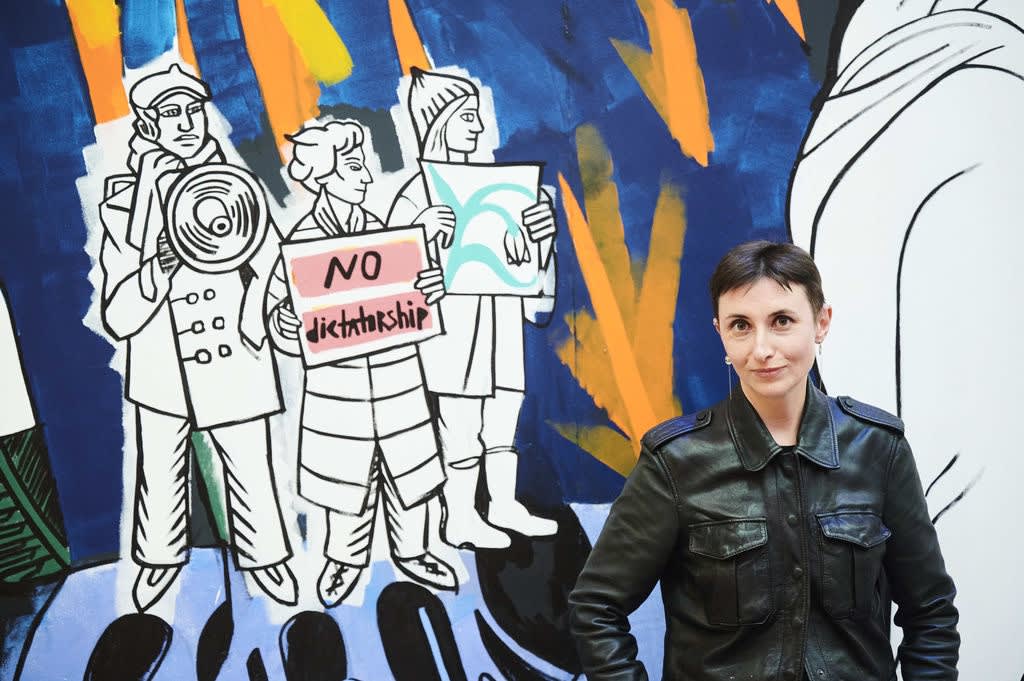The drawing was made during the arrests. In a video that was made during the last demonstration that Lomasko participated in in Moscow, you can see how she works: with large sketchbooks, she stands in the middle of the action, there are no revisions later. But even if, like Sacco, she calls her method “graphic journalism”, she is not a comic artist. Documentary individual illustrations are accompanied by long texts that explain the story. In Russia it is not her pictures but her texts that are banned. And yet Lomasko sees the drawing as the only possible reporting from her homeland, because it allows the opposition members to be anonymized and still illustrates their commitment.
16 April 2023 She fled Moscow immediately after the attack on Ukraine: Victoria Lomasko became known for her illustrated reports on opposition and repression in Russia. Now she reports in Leipzig about her experiences.
Her first name means victory, but the year 2022 meant defeat for Victoria Lomasko. She was forced to flee Moscow after the Russian invasion of Ukraine began. There is no longer room for people like Lomasko in Putin's dictatorship, and she knew it all too well.
For years she had accompanied the opposition and repression in Russia as an artist and journalist with pictures and texts: the trial against the feminist punk band Pussy Riot, street demonstrations, the scant freedom for non-conformist young people in underground clubs in the capital and retreats of the LGBTQ scene. In the summer of 2020, Lomasko went to Minsk to document the revolt against the Lukashenko regime. When hopes of a revolution were dashed, she returned to Moscow. Exhibition and publication bans followed. In the end, she didn't want to wait any longer for the security forces to come and arrest her, including beatings or rape. She left her country in February 2022. She finally found refuge in Leipzig in November, as a scholarship holder of the local gallery for contemporary art (GfZK). One year financial security. But also a year of peace? Not yet. Not for Ukraine and not for Lomasko.
The American comic journalist Joe Sacco, who is akin to her politically and aesthetically, wrote to me that I had to meet Lomasko – sometimes information needs detours of tens of thousands of kilometers. We met in January and there was a disillusioned woman sitting in front of me. Not because she has lost hope for her country - Lomasko says despite everything: "We will see a change in Russia that will make the arts flourish, and I will return to Moscow to publish my work in Russian again" - , but because she despaired of her host country. Before that she had been able to do an exhibition in Brescia, Italy, and after the summery, friendly Italy, Germany had presented itself to her in wintry and bureaucratic gray. Refugee with scholarship? The immigration authorities took four months to get a residence permit, and that's how long Lomasko was excluded from normal life: no bank account, no travel. She doesn't speak German, she's working on her English.
Not their pictures, but their texts are forbidden
The day before yesterday she presented her book The Last Soviet Artist (Diaphanes), which had just been published in German, in GfZK, in English and for the first time in a public appearance without a Russian interpreter. The hall was full, a lot of young people, and what Lomasko, who was born in 1978, told, made the evening stand still at times. For example, when she spoke of the "most dangerous moment of my life", not while fleeing, but in 2020 as a process observer in Minsk at a trial against a strike committee, when suddenly masked men in front of the courtroom apparently indiscriminately dragged away women who had come to kill the accused support. A picture of this attack on the group can be seen in The Last Soviet Artist. However, she does not mention in the book that Lomasko was part of the group herself.

Victoria Lomasko in front of some of her characters.
But even here the risk increases, and so Victoria Lomasko has moved from documentary to symbolic representation: "Fantastic pictures are more realistic than anything else," she says now, and in Leipzig she has been able to rent a studio, the first of her life, in where she can experiment with larger formats. She will never get here, but the despair is no longer there. Who needs German when there is a new poetic visual language of your own?

